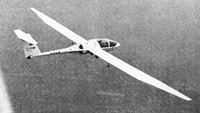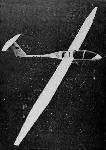
Описание
Страна : Германия
Год : 1970
Планер
Единственный экземпляр
Single-seat high-performance powered sailplane
Варианты
- Caproni Vizzola - Calif - 1969 - Италия
- Rhein-Flugzeugbau (RFB) - Sirius - 1970 - Германия
M.Hardy. Gliders & Sailplanes of the world
Rhein-Flugzeugbau Sirius
The Sirius 1 single-seat high performance motor glider was developed primarily to investigate the efficiency of the ducted fan as a powerplant for sailplanes, and its use of a new integrated power system enabled a sailplane's aerodynamic qualities to be retained virtually uncompromised by the drag of a conventional tractor or pusher engine installation, at the same time making powered take-offs from small airfields possible. The Sirius 1 was developed from the basically all-metal VFW-Fokker FK-3, but was of combined metal and glassfibre construction, and in its initial form was powered by a 48hp Nelson 'flat four' air-cooled two-stroke driving an eight-bladed ducted metal fan coupled directly to the engine. The powerplant is a fixed low drag installation fitted at the cg, the fan exhausting down the length of the tail boom; fuel capacity is 7 Imp gallons and an electrical starter enabled the engine to be restarted in flight easily. The Sirius 1 was later fitted with two Yamaha motorcycle engines, and finally with two 20hp Finkel & Sachs Wankel rotary engines. It had cantilever mid-set wings with flaps variable in movement from -10° to +15°, and conventional air brakes just ahead of the flaps. There was a retractable monowheel with brake shoes, and a tailwheel, and the Sirius 1 could be landed with the wheel retracted. The tail unit resembled that of the VFW-Fokker FK-3, and the pilot sat on a glassfibre seat under a large sideways-hinged Perspex canopy; he could be provided with radio, oxygen equipment and a barograph.
The Sirius II is a side-by-side two-seater development of the Sirius 1 which utilised the wings, tail unit and landing gear of the Caproni Vizzola Calif A-21S; this version made its first flight in January 1972 and the wing span was now 66ft 10 1/4 in and aspect ratio 25.8 compared to the Sirius 1's 57ft 6 1/2in and 22.0, while length was increased by 2ft 3in. Powerplant consists of two 30hp Wankel rotary engines coupled to drive a ducted fan in an installation similar to that of the Sirius 1, one engine being mounted in front of the fan and the other behind it. The fan shroud has an annular slat-type intake around the wing leading edge to keep the airflow attached to the duct and prevent its breakaway; suck-in doors shut to fair off this intake when the powerplant is not operating, so as to enable the soaring performance to be maintained unaffected by drag. Fuel capacity is 6.6 Imp gallons.
Data: Sirius II
Span: 66 ft 10 1/4 in
Length: 26 ft 4 1/2 in
Height: 5 ft 11 in
Wing area: 173 sq ft
Aspect ratio: 25.8
Empty weight: 1,124 lb
Max weight: 1,521 lb
Max speed: 168 mph (power on)
Min sinking speed: 1.97 ft/sec
Best glide ratio: 38:1
Take-off run: 656 ft
Range: 168 miles
- M.Hardy. Gliders & Sailplanes of the world
Фотографии
-
Jane's All the World Aircraft 1972 / 03 - Sailplanes
Регистрационный номер: D-KIFB RFB Sirius single-seat high-performance powered sailplane with ducted-fan engine
-
Jane's All the World Aircraft 1974 / 03 - Sailplanes
Регистрационный номер: D-KAFB [2] VFW-Fokkers' Rhein-Flugzeugbau subsidiary is now flight testing the Sirius II in its investigation of integrated ducted fan propulsion. First flown on 18 January 1972, Sirius II has two 30 hp Fichtel & Sachs Wankel-type engines driving the high-speed propeller that is contained in a duct forming an integral part of fuselage design, and the wing and tail unit of a Caproni Vizzola Calif A 21 sailplane. Use of Wankel type engines makes intermediate gears unnecessary and two-engined reliability is achieved with a single propeller.
-
Jane's All the World Aircraft 1975 / 03 - Sailplanes
Регистрационный номер: D-KAFB [2] RFB Sirius II two-seat high-performance powered sailplane with ducted fan power plant
-
Jane's All the World Aircraft 1972 / 03 - Sailplanes
RFB Sirius II two-seat sailplane with ducted-fan auxiliary engine
- Фотографии



